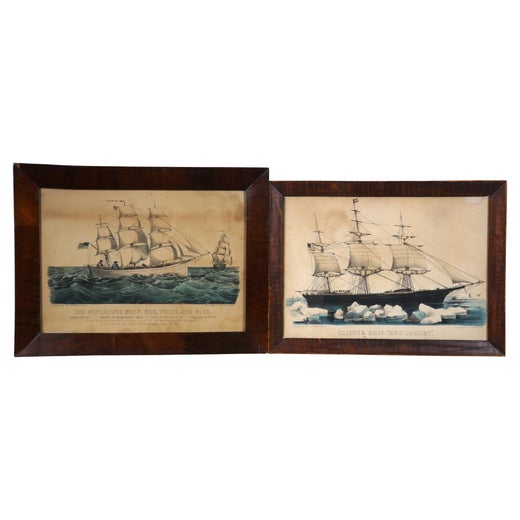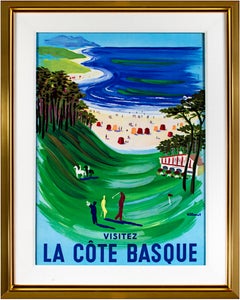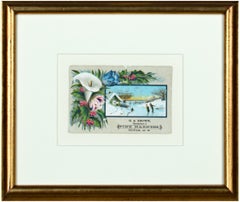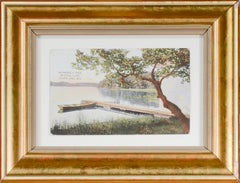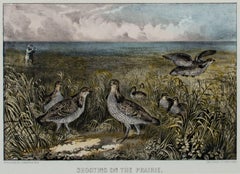Want more images or videos?
Request additional images or videos from the seller
1 of 10
Currier & Ives"Winter Morning in the Country, " Hand-Colored Lithograph by Currier & Ives1873
1873
Price:$5,700
About the Item
- Creator:Currier & Ives (1834 - 1907, American)
- Creation Year:1873
- Dimensions:Height: 18 in (45.72 cm)Width: 21 in (53.34 cm)
- Medium:
- Period:
- Condition:
- Gallery Location:Milwaukee, WI
- Reference Number:Seller: 7911g1stDibs: LU60532631023
Currier & Ives
Currier and Ives was a prominent American printmaking establishment headquartered in New York operating from 1835 to 1907. Nathaniel Currier (1813-1888) started his business on his own, but later merged with James Merritt Ives (1824-1895), becoming "Currier and Ives" in 1857. They produced and sold hand-colored lithographs which could be produced relatively quickly and cheaply. They called themselves "the Grand Central Depot for Cheap and Popular Prints". The company published around 7,500 lithographs in its 72 years in business.
About the Seller
4.9
Gold Seller
Premium sellers maintaining a 4.3+ rating and 24-hour response times
Established in 1966
1stDibs seller since 2017
451 sales on 1stDibs
Typical response time: 2 hours
Authenticity Guarantee
In the unlikely event there’s an issue with an item’s authenticity, contact us within 1 year for a full refund. DetailsMoney-Back Guarantee
If your item is not as described, is damaged in transit, or does not arrive, contact us within 7 days for a full refund. Details24-Hour Cancellation
You have a 24-hour grace period in which to reconsider your purchase, with no questions asked.Vetted Professional Sellers
Our world-class sellers must adhere to strict standards for service and quality, maintaining the integrity of our listings.Price-Match Guarantee
If you find that a seller listed the same item for a lower price elsewhere, we’ll match it.Trusted Global Delivery
Our best-in-class carrier network provides specialized shipping options worldwide, including custom delivery.You May Also Like
Untitled abstract seaside, original lithograph
By François Desnoyer
Located in Belgrade, MT
Pencil signed black and white lithograph original limited edition pencil signed , Guilde De La Gravure. Mid 20th Century, part of my private collection. Very Good condition.
Category
Mid-20th Century Cubist Figurative Prints
Materials
Lithograph
$636 Sale Price
33% Off
H 13 in W 15 in
Greenland Falcon "Falco Candicans": A 19th C. Hand-colored Lithograph by Gould
By John Gould and Henry Constantine Richter
Located in Alamo, CA
This is an original 19th century hand-colored folio-sized lithograph entitled "Falco Candicans" (Greenland Falcon Light) by John Gould, from his "Birds of Great Britain", published i...
Category
Mid-19th Century Naturalistic Animal Prints
Materials
Lithograph
$3,575
H 32.13 in W 25.5 in D 1.25 in
Le Perron (The Porch) /// French Impressionist Henri Le Sidaner Garden Landscape
By Henri Le Sidaner
Located in Saint Augustine, FL
Artist: Henri Le Sidaner (French, 1862-1939)
Title: "Le Perron (The Porch)"
Portfolio: Gazette des Beaux-Arts
*Issued unsigned, though signed by Sidaner in the plate (printed signature) lower right
Year: 1911
Medium: Original Lithograph on soft-cream Simili Japon paper
Limited edition: approx. 1,500
Printer: Maison Fortier and Marotte, Paris, France
Publisher: Gazette des Beaux-Arts, Paris, France
Reference: Sanchez and Seydoux 1911, No. 12
Sheet size: 10.75" x 7.13"
Image size: 7.5" x 5.75"
Condition: Light toning to sheet. It is otherwise a strong impression in excellent condition
Notes:
Printed in one color: blue.
This lithograph was published by Gazette des Beaux-Arts. The Gazette des Beaux-Arts was a French art review, found in 1859 by Édouard Houssaye, with Charles Blanc as its first chief editor. Assia Visson Rubinstein was chief editor under the direction of George Wildenstein from 1928 until 1960. Her papers, which include all editions of the Gazette from this period, are intact at the Cantonal and University Library of Lausanne in Dorigny. The Gazette was a world reference work on art history for nearly 100 years - one other editor in chief, from 1955 to 1987, was Jean Adhémar. It was bought in 1928 by the Wildenstein family, whose last representative was Daniel Wildenstein, its director from 1963 until his death in 2001. The review closed in 2002.
Biography:
Sidaner, (7 August 1862 – July 1939), an intimist painter, born to a French family in Port Louis, Mauritius. In 1870 he and his family settled in Dunkirk. Le Sidaner received most of his tutelage from the École des Beaux-Arts under the instruction of Alexandre Cabanel but later broke away due to artistic differences. Between 1885 and 1894 Le Sidaner lived the year round at the Etaples art colony and was joined there by his childhood friend Eugène Chigot...
Category
Early 1900s Post-Impressionist Landscape Prints
Materials
Lithograph
Sunday in the Isle de France /// Contemporary City Street Scene River People Art
By Urbain Huchet
Located in Saint Augustine, FL
Artist: Urbain Huchet (French, 1930-2014)
Title: "Sunday in the Isle de France"
*Signed by Huchet in pencil lower right
Year: 1985
Medium: Original Lithograph on unbranded white wove...
Category
1980s Contemporary Landscape Prints
Materials
Lithograph
Gerona Cathedral urbanscape lithograph
By Josep Moscardo
Located in Sitges, Barcelona
Josep Moscardó (1953) - Girona Cathedral
Lithograph - Hand signed
Lithograph measures 74x52 cm.
Frameless.
Numbered 121/150
Barcelona, 1953
Painter, s...
Category
1990s Post-Impressionist Landscape Prints
Materials
Lithograph
$202 Sale Price
43% Off
H 29.14 in W 20.48 in
Robert N. Robathan, Canyon
Located in New York, NY
Robert N. Robathan was raised in Los Angeles. This lithograph has the blind stamp of the noted California printer, Lynton Kistler, at the lower left.
An impression of this subject i...
Category
Mid-20th Century Abstract Abstract Prints
Materials
Lithograph
Clemente Untitled B: surreal mythical landscape, voyage with ocean, Venus, snake
By Francesco Clemente
Located in New York, NY
A black and white, large-scale surreal mythical landscape of an ocean voyage, with a snake wrapped around a clock, a ship, Venus sculpture, greek urns, and snakes, printed in black o...
Category
1980s Contemporary Figurative Prints
Materials
Lithograph
$2,975
H 26.75 in W 119.25 in
Nautical Triptych Blue Pebble Beach Handmade Cyanotype, Watercolor Paper
By Kind of Cyan
Located in Barcelona, ES
This series of cyanotype triptychs showcases the beauty of nature scenes, including stunning beaches and oceans, as well as the intricate textures of water, forests, and skies. These...
Category
2010s American Realist Landscape Prints
Materials
Paper, Lithograph, Monotype
Duo of Blue Egyptian Palms, Botanical Diptych Cyanotype on Paper, Vintage Modern
By Kind of Cyan
Located in Barcelona, ES
Exclusive limited edition cyanotype diptych.
Details:
+ Title: Duo of Egyptian Palms
+ Year: 2024
+ Edition Size: 20
+ Medium: Cyanotype on Watercolor Paper...
Category
2010s Naturalistic Landscape Prints
Materials
Lithograph, Handmade Paper
Rain Over Mountain, Modern Art in Blue Tones, Landscape, Cyanotype Monotype 2024
By Kind of Cyan
Located in Barcelona, ES
This is an exclusive handprinted unique cyanotype that takes its inspiration from the mid-century modern shapes.
It's made by layering paper cutouts and different exposures using uv-...
Category
2010s Modern Abstract Prints
Materials
Watercolor, Lithograph, Monotype, Paper
More From This Seller
View All'La Côte Basque' original lithograph travel poster with beach and golf
By Bernard Villemot
Located in Milwaukee, WI
This poster, titled 'La Côte Basque' in the image, was intended to draw people to travel to the Basque coast of Spain. The image is dominated by the serene blues, greens and yellows of the golf course and sandy beach. Throughout the vista, figures can be seen at leisure golfing, riding horseback, eating at restaurants, and sunbathing.
34 x 23.75 inches, poster
43.5 x 33.25 inches, image
Signed in the stone, lower right
Framed to conservation standards using archival materials including 100 percent rag mounting, UV5 Plexiglas to inhibit fading, and housed in a gold finished wood moulding with a 3-inch Belgian linen liner.
Bernard Villemot (1911 – 1989) was a French graphic artist known primarily for his iconic advertising images for Orangina, Bally Shoe, Perrier, and Air France. He was known for a sharp artistic vision that was influenced by photography, and for his ability to distill an advertising message to a memorable image with simple, elegant lines and bold colors. From 1932 to1934, he studied in Paris with artist Paul Colin, who was considered a master of Art Deco. From 1945 to 1946, Villemot prepared posters for the Red Cross. In the late 1940s, he also began a famous series of travel posters for Air France that would continue for decades. In 1949, Villemot's works were exhibited with those of his contemporary poster artist Raymond Savignac at the Gallery of Beaux Arts in Paris. In 1953, Villemot began designing logos and posters for the new soft drink Orangina, and over time these works would become some of his best known. In 1963, the Museum of Decorative Arts in Paris held an exhibition of his works. By the end of his life in 1989, he was known as one of the last great poster artists, and many collectors and critics consider him to be the "painter-laureate of modern commercial art." Since his death in 1989, his memorable images have been increasingly sought after by collectors. At least three books have been published that survey his art: "Les affiches de Villemot," by Jean-Francois Bazin...
Category
1960s Modern Landscape Prints
Materials
Lithograph
Original Victorian card with flower arrangement and ice skating scene
Located in Milwaukee, WI
Business cards like this fall into the category of what art historians today generally refer to as "ephemera." Ones like this were produced for companies in the late 19th century, pr...
Category
1890s Romantic Still-life Prints
Materials
Lithograph
Postcard with view of Rudberg's Pier, Beaver Lake, Hartland, Wisconsin
Located in Milwaukee, WI
With the invention of the halftone print process, photographic postcards like this became inexpensive to produce and became widely distributed in the first decades of the 20th centur...
Category
Early 1900s Tonalist Landscape Photography
Materials
Lithograph
19th century color lithograph birds landscape nature grass sky water figure
By Currier & Ives
Located in Milwaukee, WI
"Shooting on the Prairie" is an original hand-colored lithograph by Currier & Ives. It depicts a hunter shooting at fowl in an open field.
8 1/2" x 12 1/2" art
20 1/4" x 23 3/4" frame
Nathaniel Currier was a tall introspective man with a melancholy nature. He could captivate people with his piercing stare or charm them with his sparkling blue eyes. Nathaniel was born in Roxbury, Massachusetts on March 27th, 1813, the second of four children. His parents, Nathaniel and Hannah Currier, were distant cousins who lived a humble yet spartan life. When Nathaniel was eight years old, tragedy struck. Nathaniel’s father unexpectedly passed away leaving Nathaniel and his eleven-year-old brother Lorenzo to provide for the family. In addition to their mother, Nathaniel and Lorenzo had to care for six-year-old sister Elizabeth and two-year-old brother Charles. Nathaniel worked a series of odd jobs to support the family, and at fifteen, he started what would become a life-long career when he apprenticed in the Boston lithography shop of William and John Pendleton.
A Bavarian gentleman named Alois Senefelder invented lithography just 30 years prior to young Nat Currier’s apprenticeship. While under the employ of the brothers Pendleton, Nat was taught the art of lithography by the firm’s chief printer, a French national named Dubois, who brought the lithography trade to America.
Lithography involves grinding a piece of limestone flat and smooth then drawing in mirror image on the stone with a special grease pencil. After the image is completed, the stone is etched with a solution of aqua fortis leaving the greased areas in slight relief. Water is then used to wet the stone and greased-ink is rolled onto the raised areas. Since grease and water do not mix, the greased-ink is repelled by the moisture on the stone and clings to the original grease pencil lines. The stone is then placed in a press and used as a printing block to impart black on white images to paper.
In 1833, now twenty-years old and an accomplished lithographer, Nat Currier left Boston and moved to Philadelphia to do contract work for M.E.D. Brown, a noted engraver and printer. With the promise of good money, Currier hired on to help Brown prepare lithographic stones of scientific images for the American Journal of Sciences and Arts. When Nat completed the contract work in 1834, he traveled to New York City to work once again for his mentor John Pendleton, who was now operating his own shop located at 137 Broadway. Soon after the reunion, Pendleton expressed an interest in returning to Boston and offered to sell his print shop to Currier. Young Nat did not have the financial resources to buy the shop, but being the resourceful type he found another local printer by the name of Stodart. Together they bought Pendleton’s business.
The firm ‘Currier & Stodart’ specialized in "job" printing. They produced many different types of printed items, most notably music manuscripts for local publishers. By 1835, Stodart was frustrated that the business was not making enough money and he ended the partnership, taking his investment with him. With little more than some lithographic stones, and a talent for his trade, twenty-two year old Nat Currier set up shop in a temporary office at 1 Wall Street in New York City. He named his new enterprise ‘N. Currier, Lithographer’
Nathaniel continued as a job printer and duplicated everything from music sheets to architectural plans. He experimented with portraits, disaster scenes and memorial prints, and any thing that he could sell to the public from tables in front of his shop. During 1835 he produced a disaster print Ruins of the Planter's Hotel, New Orleans, which fell at two O’clock on the Morning of the 15th of May 1835, burying 50 persons, 40 of whom Escaped with their Lives. The public had a thirst for newsworthy events, and newspapers of the day did not include pictures. By producing this print, Nat gave the public a new way to “see” the news. The print sold reasonably well, an important fact that was not lost on Currier.
Nat met and married Eliza Farnsworth in 1840. He also produced a print that same year titled Awful Conflagration of the Steamboat Lexington in Long Island Sound on Monday Evening, January 18, 1840, by which melancholy occurrence over One Hundred Persons Perished. This print sold out very quickly, and Currier was approached by an enterprising publication who contracted him to print a single sheet addition of their paper, the New York Sun. This single page paper is presumed to be the first illustrated newspaper ever published.
The success of the Lexington print launched his career nationally and put him in a position to finally lift his family up. In 1841, Nat and Eliza had their first child, a son they named Edward West Currier. That same year Nat hired his twenty-one year old brother Charles and taught him the lithography trade, he also hired his artistically inclined brother Lorenzo to travel out west and make sketches of the new frontier as material for future prints. Charles worked for the firm on and off over the years, and invented a new type of lithographic crayon which he patented and named the Crayola. Lorenzo continued selling sketches to Nat for the next few years.
In 1843, Nat and Eliza had a daughter, Eliza West Currier, but tragedy struck in early 1847 when their young daughter died from a prolonged illness. Nat and Eliza were grief stricken, and Eliza, driven by despair, gave up on life and passed away just four months after her daughter’s death.
The subject of Nat Currier’s artwork changed following the death of his wife and daughter, and he produced many memorial prints and sentimental prints during the late 1840s. The memorial prints generally depicted grief stricken families posed by gravestones (the stones were left blank so the purchasers could fill in the names of the dearly departed). The sentimental prints usually depicted idealized portraits of women and children, titled with popular Christian names of the day.
Late in 1847, Nat Currier married Lura Ormsbee, a friend of the family. Lura was a self-sufficient woman, and she immediately set out to help Nat raise six-year-old Edward and get their house in order. In 1849, Lura delivered a son, Walter Black Currier, but fate dealt them a blow when young Walter died one year later. While Nat and Lura were grieving the loss of their new son, word came from San Francisco that Nat’s brother Lorenzo had also passed away from a brief illness. Nat sank deeper into his natural quiet melancholy. Friends stopped by to console the couple, and Lura began to set an extra place at their table for these unexpected guests. She continued this tradition throughout their lives.
In 1852, Charles introduced a friend, James Merritt Ives, to Nat and suggested he hire him as a bookkeeper. Jim Ives was a native New Yorker born in 1824 and raised on the grounds of Bellevue Hospital where his father was employed as superintendent. Jim was a self-trained artist and professional bookkeeper. He was also a plump and jovial man, presenting the exact opposite image of his new boss.
Jim Ives met Charles Currier through Caroline Clark, the object of Jim’s affection. Caroline’s sister Elizabeth was married to Charles, and Caroline was a close friend of the Currier family. Jim eventually proposed marriage to Caroline and solicited an introduction to Nat Currier, through Charles, in hopes of securing a more stable income to support his future wife.
Ives quickly set out to improve and modernize his new employer’s bookkeeping methods. He reorganized the firm’s sizable inventory, and used his artistic skills to streamline the firm’s production methods. By 1857, Nathaniel had become so dependent on Jims’ skills and initiative that he offered him a full partnership in the firm and appointed him general manager. The two men chose the name ‘Currier & Ives’ for the new partnership, and became close friends.
Currier & Ives produced their prints in a building at 33 Spruce Street where they occupied the third, fourth and fifth floors. The third floor was devoted to the hand operated printing presses that were built by Nat's cousin, Cyrus Currier, at his shop Cyrus Currier & Sons in Newark, NJ. The fourth floor found the artists, lithographers and the stone grinders at work. The fifth floor housed the coloring department, and was one of the earliest production lines in the country. The colorists were generally immigrant girls, mostly German, who came to America with some formal artistic training. Each colorist was responsible for adding a single color to a print. As a colorist finished applying their color, the print was passed down the line to the next colorist to add their color. The colorists worked from a master print displayed above their table, which showed where the proper colors were to be placed. At the end of the table was a touch up artist who checked the prints for quality, touching-in areas that may have been missed as it passed down the line. During the Civil War, demand for prints became so great that coloring stencils were developed to speed up production.
Although most Currier & Ives prints were colored in house, some were sent out to contract artists. The rate Currier & Ives paid these artists for coloring work was one dollar per one hundred small folios (a penny a print) and one dollar per one dozen large folios. Currier & Ives also offered uncolored prints to dealers, with instructions (included on the price list) on how to 'prepare the prints for coloring.' In addition, schools could order uncolored prints from the firm’s catalogue to use in their painting classes.
Nathaniel Currier and James Merritt Ives attracted a wide circle of friends during their years in business. Some of their more famous acquaintances included Horace Greeley, Phineas T. Barnum, and the outspoken abolitionists Rev. Henry Ward, and John Greenleaf Whittier (the latter being a cousin of Mr. Currier).
Nat Currier and Jim Ives described their business as "Publishers of Cheap and Popular Pictures" and produced many categories of prints. These included Disaster Scenes, Sentimental Images, Sports, Humor, Hunting Scenes, Politics, Religion, City and Rural Scenes, Trains, Ships, Fire Fighters, Famous Race Horses, Historical Portraits, and just about any other topic that satisfied the general public's taste. In all, the firm produced in excess of 7500 different titles, totaling over one million prints produced from 1835 to 1907.
Nat Currier retired in 1880, and signed over his share of the firm to his son Edward. Nat died eight years later at his summer home 'Lion’s Gate' in Amesbury, Massachusetts. Jim Ives remained active in the firm until his death in 1895, when his share of the firm passed to his eldest son, Chauncey.
In 1902, faced will failing health from the ravages of Tuberculosis, Edward Currier sold his share of the firm to Chauncey Ives...
Category
1870s Other Art Style Animal Prints
Materials
Lithograph
19th century landscape color lithograph seascape buildings cityscape houses
Located in Milwaukee, WI
"Chicago in Early Days" is an original color lithograph by Kurz & Allison. This piece features multiple views of the city of Chicago.
16 3/4" x 23 1/4" art
28 1/8" x 33 7/8" frame
...
Category
1890s Academic Landscape Prints
Materials
Lithograph
"Circuit De L'Est" Original Aeronautical Lithograph Poster by Marguerite Montaut
By Marguerite Montaut
Located in Milwaukee, WI
"Circuit De L'Est" is an original lithograph poster by Marguerite Montaut (GAMY). This artwork features an early biplane flying over farm fields. It is also passing over a river that...
Category
1910s Modern Landscape Prints
Materials
Lithograph, Ink
Recently Viewed
View AllMore Ways To Browse
Antique Architectural Plans
Antique Printing Press
Christian Dior Two Piece Set
Antique Shop Fronts
Antique Civil War Prints
Antique Milk Container
W Rochelle
Welliver Screen Print
Wilbur Streech
William Irvine
William Simpson On Sale
Wysocki Charles Signed
Karapet Balakeseryan
Kuno Vollet Orbit
Lanvin Arpege Perfume
Lner Poster
Lone Ranger
Marina City
